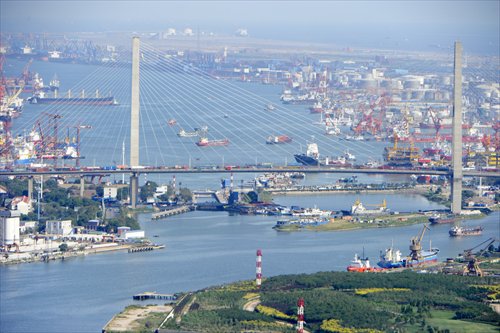Tianjin Port gets green light for expansion
Shares surge as group plans to double anchorage berths

An overview of Tianjin Port Photo: CFP

The share price of Tianjin Port Holdings Co, the Shanghai-listed arm of Tianjin Port (Group), surged by the daily limit Wednesday after the State Council authorized the port's expansion plans to double anchorage berths.
Tianjin Port is the largest port in North China and one of the world's largest ports by shipping volume.
The State Council has recently approved plans for the port to enlarge the acreage of operational waters to 1,590 square kilometers, extending its waterfront length for docks from 78.9 kilometers to 148 kilometers, and increase the number of berths from 75 to 146, according to media reports.
The market reacted to the news by sending the share price of Tianjin Port Holdings Co soaring by the daily limit of 10 percent to 11.88 yuan ($1.94) per share Wednesday. The port's subsidiary listed in the Hong Kong stock exchange gained 4.27 percent on Wednesday to HK$1.71 ($0.22) per share, around the highest in three and a half years. During the past three days, the share price has risen by nearly 20 percent on the news.
But Zheng Ping, chief analyst of industry portal chineseport.cn, said the share price is driven more by expectations of Tianjin Port becoming China's next free trade zone, and less by the expansion plan itself.
"China (Shanghai) Pilot Free Trade Zone has been trialed for about a year and has made some good achievements. Tianjin and Guangzhou stand as next two potential candidates," Zheng told the Global Times.
He noted many Chinese ports have seen their share prices rise substantially, fueled by the free trade zone frenzy.
"The short-term fluctuations in share prices are due largely to technical reasons, such as speculation. But the general prospects of the Beijing-Tianjin-Hebei bloc are certainly improving," Zhang Gui, deputy director of the Center for Beijing-Tianjin-Hebei Development Research at the Hebei University of Technology, told the Global Times Wednesday.
The development of the Beijing-Tianjin-Hebei bloc is a national strategy outlined by China's central government in early 2014.
Led by Tianjin Port, the share price of Shanghai-listed Tianjin Tianbao Infrastructure Co also surged by its daily limit to 8.15 yuan per share and Tianjin Marine Shipping grew by 3.22 percent to 9.3 yuan per share.
Tianjin Port handled over 500 million tons of cargos in 2013, making it the 4th largest port in the world, according to its website. It was also ranked as the world's 11th largest container port with 13 million twenty-foot equivalent units (TEUs) handled in 2013.
Besides further expanding into the sea, Tianjin Port also plans to further increase the number of its land ports to 10 in the regional bloc, with new land ports built in cities such as Tangshan and Langfang.
Land ports handle customs clearance in the hinterland and send cargoes that can be directly loaded on to ships anchoring in ports.
Tianjin Port currently has 23 land ports in China, five of which are located in Beijing and Hebei, according to a report by the China Business Journal newspaper in September.
The container cargo handled by Port of Tianjin accounted for four-fifths of the total in the Beijing-Tianjin-Hebei area, according to a report by the China Business News on August 20.
Tianjin Port announced on August 18 that it will form a joint venture with Hebei Port Group with an investment of up to 1 billion yuan.
Experts say the announcement marked a change of attitude as the ports from Tianjin municipality and Hebei Province tended to compete fiercely over the past few years.
"Although the joint venture only manages a small, overlapping business between the two groups, the cooperation is a sign that the rivalry between the two port groups has tempered a bit. However, the two sides still have a lot to negotiate over a range of issues from shipping routes to land use," Zhang said.
Separately, the Beijing Times reported Wednesday that the work on an integrated regional bloc is making steady progress as relevant departments have completed and submitted eight maps, which contain features such as demographic and traffic layouts in the region, to the government.